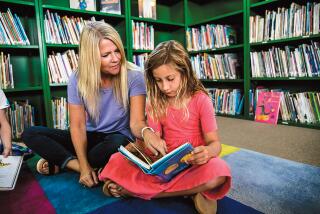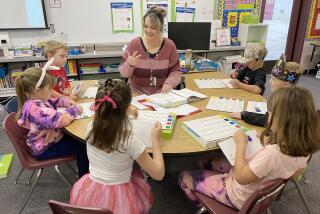Do Rewards for Reading Really Work?
- Share via
Scrap the Snoopy stickers, the grape-scented purple erasers and the pepperoni pizzas.
Long used by teachers, librarians, principals and parents hoping to entice children to read, these and other rewards are ineffective and may actually hinder the desire to open a book, more and more researchers say.
“Rewards don’t work,” said Jeff McQuillan, an assistant professor of education at Arizona State University and author of several literacy studies, including a review of incentive programs.
That is not exactly comforting news to school districts and public libraries in California and nationwide that for decades have showered trinkets, gifts and candy on children who show the slightest inclination toward picking up a book. And although there are no hard data available, literacy experts say the propensity to parcel out prizes is on the rise as educators engage in the desperate struggle to motivate students to read.
Even teachers and librarians who approve of incentives said that, if used frequently, pencils, T-shirts, skating rink passes and other prizes can breed suspicion among students and turn them off to reading.
“Any self-respecting kid would wonder, ‘Why am I getting a reward if I’m supposed to love it?’ ” said Marilyn Robertson, president-elect of the California School Library Assn.
And one self-respecting student--Carmelita Arreguin, 11, a sixth-grader at Northridge Middle School--heartily agrees.
“Why do they give us stuff if it’s supposed to be fun?” she said. “I like getting the stuff, but it doesn’t matter. I’ll still read.”
Indeed, that is exactly what research by McQuillan and others shows.
In a 1997 article published in the journal Reading Research and Instruction, McQuillan reviewed 10 academic studies on incentive programs and found that they had no effect on the habits, achievements or motivation of students.
What works, he and others say, is a “chicken or the egg” dynamic. The best way to reward children for reading is to give them more books and time to read them.
In a forthcoming study of low-achieving students at Anaheim High School, McQuillan found that teenagers embrace reading when they see adults reading for pleasure, and when they have access to books and at least 10 minutes a day of silent reading, with no tests.
The effect was so powerful that Anaheim High students lined up before class last winter after English teacher Sue Snyder bought 120 new books for her classroom. Her class was included in the study and, for three weeks before her shopping spree, she asked students what authors and subjects they would like.
Preferences ranged from Judy Blume to Barbara Kingsolver, from the Goosebumps series to Sweet Valley High. They were so excited about being able to read the books they wanted to read, Snyder said, that half a dozen students were waiting at her door to borrow books.
Snyder also gives students at least 20 minutes of daily reading time. Snyder also reads with them, sometimes at her desk or joining students on the floor or on one of the two couches in the classroom. Sometimes, she piques their interest by laughing out loud or expressing anger at a character’s actions.
“Students will want to know more and, before you know it, we’ll be talking about books,” Snyder said. “You don’t need incentives if you have good books.”
Yet studies show that California’s school libraries have some of the worst books-to-pupil ratios in the nation, while the public libraries also lag behind other states in books per resident and hours of operation.
All the more reason to stop spending money on reading rewards, said McQuillan, a former Cal State Fullerton professor who wrote the 1998 book “The Literacy Crisis: False Claims, Real Solutions.”
“The tragedy of incentive programs is that they take money away from the purchase of books,” he said. “So while our libraries languish, schools are spending money on fast-food coupons and trinkets. It’s crazy.”
But school officials and librarians argue that many of the incentives are donated or paid for through personal funds. For example, Pizza Hut donates for its popular “Book It!” program, in which students who meet monthly reading goals receive free coupons and pizza.
And many educators are firmly wedded to the concept of “read a book, get a pizza.” Anything that helps to put a child’s nose in a book is good, they say.
At Nobel Middle School in Northridge, officials are taking the middle ground. Students who finish 15 books from a library-approved list can receive a free lunch from the nearby Sizzlers--and a paperback from Barnes & Noble.
The rewards are funded by the $1 fee reading club members pay at the beginning of the school year. Nobel librarian Shirley McCauley estimated that 300 to 400 enroll in the club, while only 12 to 16 students--about 4%--earn the meal and book.
“I have mixed emotions about rewards,” McCauley said. “They’re tangible and instantaneous but can be overdone. Really, reading is the reward.”
*
* SOUTHERN CALIFORNIA LIVING: Bridget is an alligator who resents being mistaken for a boy. Her story and a slew of others focus on strong girl characters. E5
More to Read
Sign up for Essential California
The most important California stories and recommendations in your inbox every morning.
You may occasionally receive promotional content from the Los Angeles Times.













